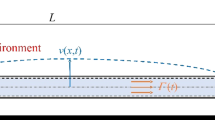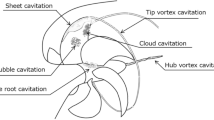Abstract
The cavitation performance of propellers is studied based on viscous multiphase flow theories. With a hybrid grid based on Navier-Stokes (N-S) and bubble dynamics equations, some recent validation results are presented in this paper in the predictions of the thrust, the torque and the vapor volume fraction on the back side of propeller blade for a uniform inflow. The numerical predictions of the hydrodynamic performance and the sheet cavitation under several operating conditions for two propellers agree with the corresponding measured data in general. The thrust and the torque are plotted with respect to the advance rate and the cavitation number. The cavitation performance breakdown is closely related to the strong sheet cavitation around propellers. The models with parameters modified are shown to predict the propeller cavitation well.
Similar content being viewed by others
References
YE Jin ming, XIONG Ying and LI Fang et al. Experimental study of effects of air content on cavitation and pressure fluctuations[J]. Journal of Hydrodynamics, 2010, 22(5): 634–638.
FELLI M., GUJ G. and CAMUSSI R. Effect of the number of blades on propeller wake evolution[J]. Experimental in Fluids, 2008, 44(3): 409–418
GUO Chun-yu, MA Ning and YANG Chen-jun. Numerical simulation of a podded propulsor in viscous flow[J]. Journal of Hydrodynamics, 2009, 21(1): 71–76.
ZHANG Ling-xin, ZHAO Wei-guo and SHAO Xue-ming. A pressure-based algorithm for cavitating flow computa-tions[J]. Journal of Hydrodynamics, 2011, 23(1): 42–47.
GHASSENI H., GHADIMI P. Numerical analysis of the high skew propeller of an underwater vehicle[J]. Journal of Marine Science Application, 2011, 10: 289–299.
LINDAU J. W., BOGER D. A. and MEDVITZ R. B. et al. Propeller cavitation breakdown analysis[J]. Journal of Fluids Engineering, 2005, 127(5): 995–1002.
LINDAU J. W., KUNZ R. F. and BOGER D. A. et al. High Reynolds number, unsteady, multiphase Cfd modeling of cavitation flows[J]. Journal of Fluids Engineering, 2002, 124(6): 607–616.
RHEE S. H., KAWAMURA T. and LI H. Propeller cavi-tation study using an unstructured grid based Navier-Stokes solver[J]. Journal of Fluids Engineering, 2005, 127(5): 986–994.
JI Bin, LUO Xian-wu and WANG Xin et al. Unsteady numerical simulation of cavitating turbulent flow around a highly skewed model marine propeller[J]. Journal of Fluids Engineering, 2011, 133(1): 011102.
SINGHAL A. K., ATHAVALE M. M. and LI H. et al. Mathematical basis and validation of the full cavitation model[J]. Journal of Fluids Engineering, 2002, 124(3): 617–624.
ORSZAG S. A. Near wall turbulent flows[M]. Amsterdam, The Netherlands: Elsevier, 1993.
MARKATOS N. C., SINGAL A. K. Numerical analysis of one-dimensional, two-phase flow a vertical cylindrical pump[J]. Advance in Engineering Software, 1982, 4(3): 99–106.
PEREIRA F., SALVATORE F. and FELICE F. D. et al. Experimental and numerical investigation of the cavita-tion pattern on a marine propeller[C]. 24th Symposium on Naval Hydrodynamics. Fukuoka, Japan, 2002.
HU Jian. Research on propeller cavitation characteristics and low noise propeller design[D]. Ph. D. Thesis, Harbin: Harbin Engineering University, 2006.
ZHU Zhi-feng, FANG Shi-liang and WANG Xiao-yan. Nnumerical method for viscous cavitating flow around ship propeller[J]. Journal of Southeast University (Natural Science Edition), 2011, 40(6):1146–1151(in Chinese).
SALVATORE F., TESTA C. and GRECO L. A viscous/inviscid coupled formulation for unteady sheet cavitation modelling of marine profellers[C]. Fifth International Symposium on Cavitation (CAV2003). Osaka, Japan, 2003, 1–16.
Author information
Authors and Affiliations
Corresponding author
Additional information
Project supported by the Open Foundation of Key Laboratory of Underwater Acoustic Signal Processing of Ministry of Education, Southeast University (Grant No. UASP1102), the National Key Basic Research Program of China (973 Program Grant No. 6131222).
Biography: ZHU Zhi-feng (1972-), Male, Ph. D., Associate Professor
Rights and permissions
About this article
Cite this article
Zhu, Zf., Fang, Sl. Numerical Investigation Of Cavitation Performance of Ship Propellers. J Hydrodyn 24, 347–353 (2012). https://doi.org/10.1016/S1001-6058(11)60254-0
Received:
Revised:
Published:
Issue Date:
DOI: https://doi.org/10.1016/S1001-6058(11)60254-0




